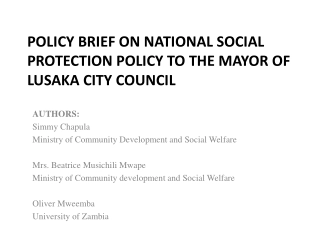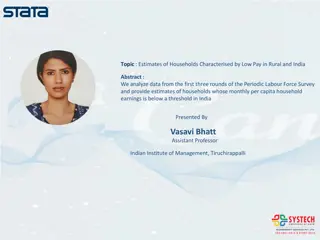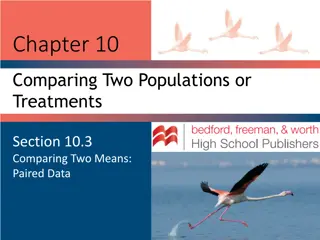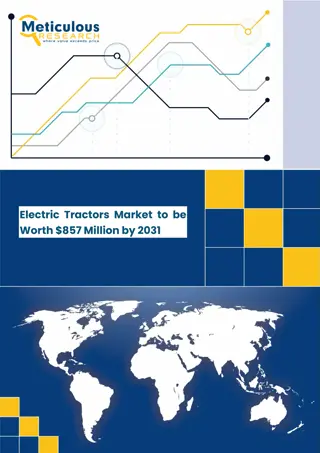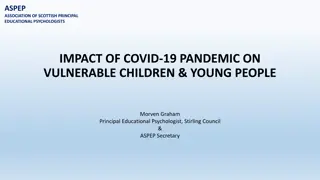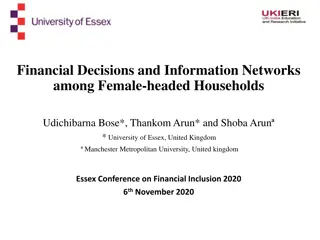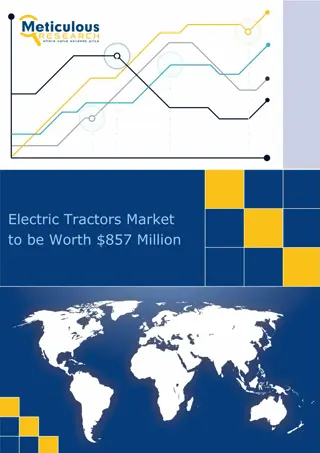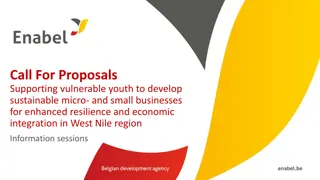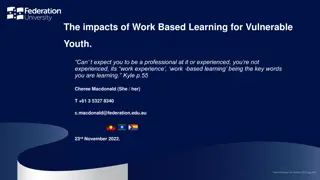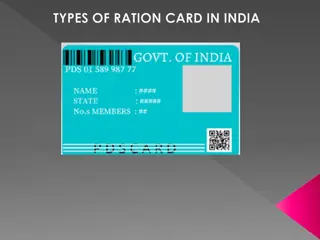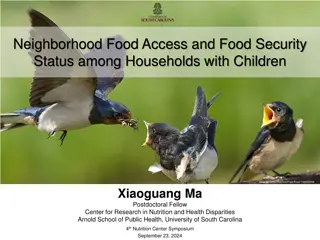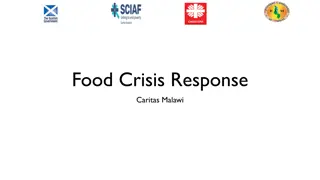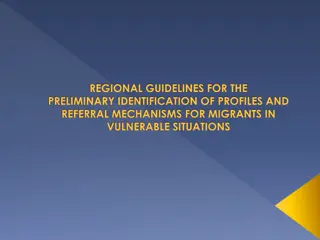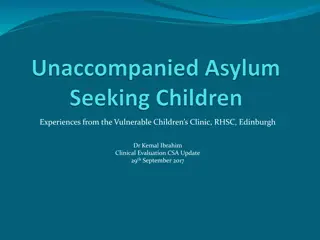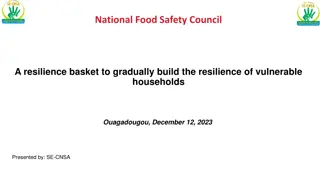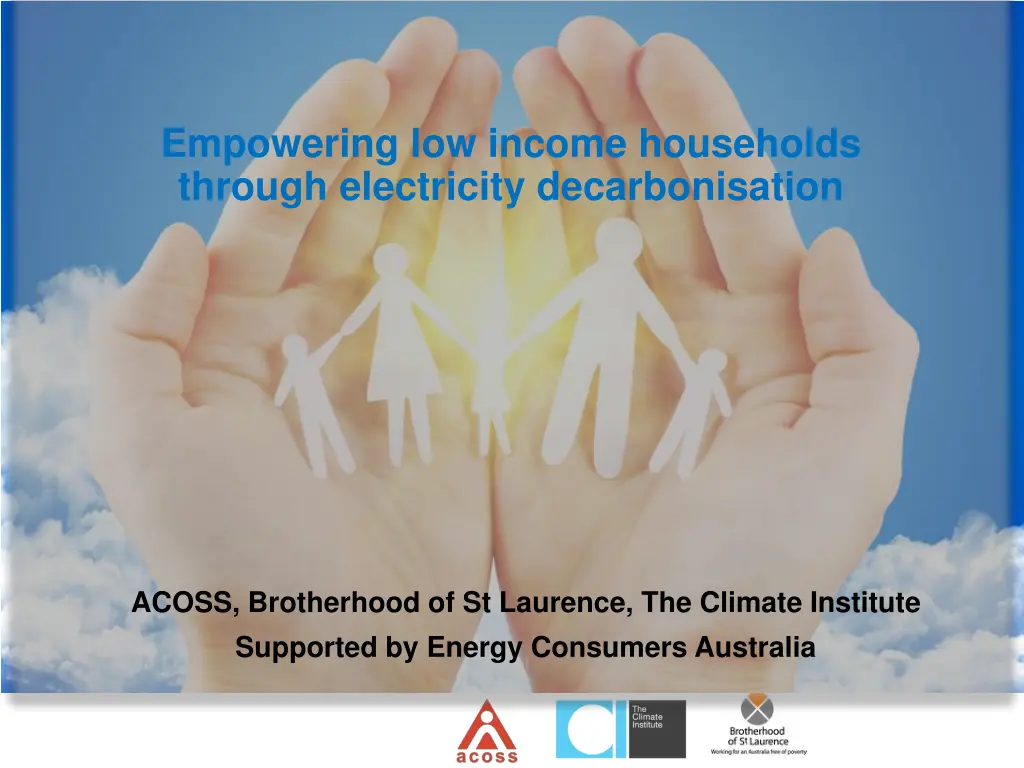
Empowering Low-Income Households Through Electricity Decarbonisation
This project by ACOSS, Brotherhood of St. Laurence, and The Climate Institute, supported by Energy Consumers Australia, aims to empower vulnerable households by addressing electricity decarbonisation, affordability, informed consumers, efficient energy consumption, and robust consumer protections. The transition to lower emissions electricity needs to be inclusive and equitable, ensuring all households have the capacity to pay. Strategies are being developed to reduce Australia's emissions and support low-income households in this energy transition.
Download Presentation

Please find below an Image/Link to download the presentation.
The content on the website is provided AS IS for your information and personal use only. It may not be sold, licensed, or shared on other websites without obtaining consent from the author. If you encounter any issues during the download, it is possible that the publisher has removed the file from their server.
You are allowed to download the files provided on this website for personal or commercial use, subject to the condition that they are used lawfully. All files are the property of their respective owners.
The content on the website is provided AS IS for your information and personal use only. It may not be sold, licensed, or shared on other websites without obtaining consent from the author.
E N D
Presentation Transcript
Empowering low income households through electricity decarbonisation ACOSS, Brotherhood of St Laurence, The Climate Institute Supported by Energy Consumers Australia
SUMMARY OF PRESENTATION Introduce the project Empowering Vulnerable Households through Decarbonisation Set the Scene Vulnerability, Energy Trilemma, Inclusive and Equitable Outcome 1 Electricity priced efficiently Outcome 2 Informed and Enabled Consumers Outcome 3 Energy Consumed Efficiently and productively Outcome 4 - Robust Consumer Protections Outcome 5 All Households have a capacity to pay Reducing Australia s Emissions We are keen to help What strategically can we do to help you? Empowering low income households through electricity decarbonisation 2
EMPOWERING HOUSEHOLDS PROJECT Purpose Transition to lower emissions electricity is inevitable; achieving zero emissions is essential (Paris Agreement objectives). This transition needs to ensure the challenges facing low income and disadvantage households are addressed. The transition needs to be inclusive and equitable. Method Commissioned research Framework 5 outcomes climate, energy and social policy National Consultations community, environment and other key stakeholders. Reference Group, ACOSS Policy Network, 120+ Results Identified priorities for critical areas of reform and to consider further policy development Empowering low income households through electricity decarbonisation 3
ENERGY TRILEMA Affordability Prices increased 80% since 2008 Uncertainty of bills - shocks Retail competition failing increasing cost Wholesale prices increasing Renewable incentives on bill increase cost - regressive Disconnections increased 47% between 2008 & 2016 More people on retail hardship programs More people accessing financial support services Rationing of energy A decade of policy instability, regulatory inaction and blame-shifting among federal and state governments is central to the deterioration of every element of the energy trilemma. Security and Reliability Being compromised in some regions No planned transition from coal to renewables Emissions Reductions Emissions in electricity is increasing Australia s targets not in line with Paris Agreement Electricity sector do heavy lifting in short term Empowering low income households through electricity decarbonisation 4
WHAT CREATES VULNERABILITY TO ENERGY STRESS? Price is only part of the story. Price pressure across supply chain Total cost and ability to pay are crucial. How energy is used Influenced by: energy technologies market design upward pressure across the supply chain, including network and retail charges When and how much energy is used level of consumer choice and control Low income & eligibility for concessions housing circumstance ability to engage Govt response to climate change risks Energy techs Choice and control Vulnerability Housing Eligibility for assistance Market designs Empowering low income households through electricity decarbonisation 5
WHO IS VULNERABLE TO ENERGY STRESS? People who: a) need to respond to electricity cost pressures, and b) can't Particularly vulnerable Renters Households where someone is living with a disability or health Single parent households Aboriginal & Torres Strait Islanders Migrants and Refugees Pensioners Working poor Emerging Housing stressed Housing tenure is a significant contributor to energy stress Empowering low income households through electricity decarbonisation 6
ALIGN ENERGY, CLIMATE & SOCIAL POLICY Climate concerns Low income/disadvantaged Australians most vulnerable to climate change impacts In Australia s interest in keeping climate change to 1.5-2 C Transition to net zero electricity supply by mid- century is necessary Energy concerns Energy system is in crisis Improve security & affordability Need new generation to replace old Need new framework to adapt to new technologies Social concerns Energy is an essential service Capacity to Pay Access Circumstances health, education, language, geography, disability Housing costs vulnerable Australians Need a planned strategy to manage transition from ageing coal-fired generation to clean energy Urgent need to make this more equitable & accessible for low income and vulnerable Australians Need to better align climate, energy and social policy Empowering low income households through electricity decarbonisation 7
WHAT IS TO BE DONE? FIVE POLICY OUTCOMES 1. Electricity priced efficiently (including integrated climate policy) 2. Informed and engaged consumers 3. Energy consumed efficiently and productively 4. Robust consumer protections 5. All households have a capacity to pay their energy bills. Developed by Andrew Nance, The Energy Project Energy as an essential service social good overarching outcome To date, most policy focus has been on the first outcome, but all need to be pursued in broadly equal measures Empowering low income households through electricity decarbonisation 8
OUTCOME 1 - ELECTRICITY PRICED EFFICIENTLY (INCLUDING INTEGRATED CLIMATE POLICY) Top Priorities Federal government work with COAG Energy Ministers to implement effective and stable policies in the electricity sector consistent with Paris Agreement objectives, comprising a carefully designed package that utilises market mechanisms, regulation and on-budget measures. Federal Government work with COAG Energy Ministers to develop policies for managed coal generator retirement and replacement in the interests of the public, energy consumers, and communities. Other important priorities Federal and state Governments support the development of community and local energy models that enable low-income and disadvantaged households to access affordable distributive energy. COAG Energy Council consider incorporating social and environmental objectives into the National Energy Market objectives (NEO) COAG Energy Ministers implement policies to improve the role and utilisation of the electricity network in contributing to demand management and distributed generation that is inclusive and equitable. Empowering low income households through electricity decarbonisation 9
OUTCOME 1 - ELECTRICITY PRICED EFFICIENTLY (INCLUDING INTEGRATED CLIMATE POLICY) 2030 prices from climate policy modelling Two views of uncertainty Future Baseload Wholesale Prices Q2 2017 160 NSW VIC QLD SA announced Hazelwoo d closure 140 announced $160 Northern Northern closure closure $140 120 $120 100 $100 $/MWh 80 $/MWh $80 60 $60 40 $40 20 $20 $- 0 Empowering low income households through electricity decarbonisation 10
OUTCOME 1 - ELECTRICITY PRICED EFFICIENTLY (INCLUDING INTEGRATED CLIMATE POLICY) How can we lower prices? Overarching Wholesale Fuel costs Sudden exits High risk premium Mismatched incentives Poor tech integration Peaky demand Insecure supply Market power More supply Less uncertainty Lower tech costs Lower fuel costs Improve tech integration Demand mgmt. Cost reflection Competition Improve productivity Predictability destination and pathway Transmiss Strategy package of measures Distributio n Objectives security, affordability, decarbonisation, social welfare Retail Innovation in service provision new models including community- driven approaches FiT RET GST Empowering low income households through electricity decarbonisation
OUTCOME 2 - INFORMED AND ENABLED CONSUMERS Top Priorities Federal and State Governments co-fund stable and ongoing assistance programs, delivered by local place based social support services to inform and enable vulnerable households engage with the energy market. Where possible these programs should strengthen relationships between vulnerable households, support services, advocates and energy retailers. COAG Energy Ministers require energy retailers to develop a low-cost, no-frills retail energy market offer that vulnerable and disengaged customers can default to if they cannot or do not engage in competitive retail energy markets. Empowering low income households through electricity decarbonisation 12
OUTCOME 2 - INFORMED AND ENABLED CONSUMERS Households who are disengaged from the energy market are paying 15-20% more than should. Some cohorts of vulnerable households are more disengaged. Inability to engage makes people more vulnerable Need to continually engage in the market to benefit. Barriers exist: Trust Transparency Understanding Retail is often unavailable and ineffective where available. Smart meters and network tariff reform: new ways of managing consumption. benefits not yet realised some households can t respond to price signals Engagement in Distributed Energy access and affordability Case Study QCOSS Switched on Communities For vulnerable households who can t engage in energy market access low cost offering. Empowering low income households through electricity decarbonisation 13
OUTCOME 2 - INFORMED AND ENABLED CONSUMERS Empowering low income households through electricity decarbonisation 14
OUTCOME 3 - ENERGY CONSUMED EFFICIENTLY & PRODUCTIVELY Top Priorities Federal Government support State and Territory Governments to introduce minimum energy efficiency standards for rental properties in all Australian jurisdictions (with reference to local climatic conditions) to improve affordability, health and wellbeing outcomes for tenants in the poorest quality dwellings. Simultaneously the Federal Government review tax policy to ensure existing tax measure support energy efficiency upgrades. Federal, State Governments and local councils work cooperatively together to co-fund ongoing programs for vulnerable and low-income households that provide access to energy efficient technologies, solar PV and other distributed resources and provide a trusted source of information. Higher levels of support should be provided to the most vulnerable households. Other important priorities Federal and State Governments provide additional support to upgrade all public and community housing stock to best practice energy efficiency standards. Empowering low income households through electricity decarbonisation 15
OUTCOME 3 - ENERGY CONSUMED EFFICIENTLY & PRODUCTIVELY Low-income households pay more for basic energy services: less efficient homes and appliances less financial capacity to invest in efficiency renting adds barriers Higher costs, disconnections, health and wellbeing impacts Key initiatives in place, but more needed: National productivity plan GEMS/MEPS for appliances many promising programs (REES in SA, NSW social housing, LIEEP) Comprehensive approach needed - Stable, long term, rather than stop start Integrate EE into housing policy, including upgrade pubic & community housing Harmonise state energy efficiency PRIORITY ACTION minimum EE standards for rental help cost, health, emission reduction Empowering low income households through electricity decarbonisation 16
OUTCOME 3 - ENERGY CONSUMED EFFICIENTLY & PRODUCTIVELY Opportunities in Distributed Energy Resources solar power, batteries, electric vehicles, smart meters can lower costs, improve affordability Also major risks: solar not accessible to renters, barriers for low income households but these households pay cost of subsidy schemes two tier electricity market? Vulnerable to grid defection PRIORITY ACTION: ongoing programs for vulnerable and low-income households that provide access to energy efficient technologies, solar PV and other distributed resources and provide a trusted source of information. Empowering low income households through electricity decarbonisation 17
OUTCOME 4 - ROBUST CONSUMER PROTECTIONS Top Priorities COAG Energy Ministers undertake a review of disconnection laws in light of the essential nature of electricity, with a view to ending the tactic of disconnecting households because of inability to pay. COAG Energy Ministers request a review of the current National Energy Customer Framework (NECF), with the following reforms in mind: Introduce Governing principles along the lines: It should be easy for people to engage and make effective decisions. Appropriate consumer protections should be applied to all energy products and services. The benefits of a transforming market should be shared across the whole community Review of current best practice protections in line with principles Establish a range of no-regrets initiatives: Testing the need for, and form of, market interventions against real consumer decision-making. Requiring energy service providers to identify the consumer s purpose in acquiring a service, to ensure it is appropriately identifying programs to assist vulnerable demographics access new products and services. Ensuring adequate access to justice by expanding the jurisdiction of energy Ombudsman schemes. Apply updated consumer protection framework in all states, with derogations for stronger protections allowable. Other important priorities COAG Energy Ministers review alternative solutions for those customers identified through Payment Difficulties or Hardship initiatives that are unable to pay for ongoing consumption, such as energy education, financial counselling and support for energy efficiency. Empowering low income households through electricity decarbonisation 18
OUTCOME 4 - ROBUST CONSUMER PROTECTIONS Electricity is an essential service 160,000 households are disconnected each year National Energy Customer Framework (NECF) inconsistently applied by states. Some jurisdictions aiming for best practice in some areas (eg. AER, ESC Vic) But current frameworks are challenged by rising prices and new technologies: - Ambit of NECF and what it applies to needs to be expanded - covers energy retailers but not, embedded energy network operators, and solar PPA/Lease - Energy supply needs to be considered as a whole, rather than arbitrarily divided between the retail market and everything else Overarching principle The need for, and level of, regulatory intervention in the interest of providing consumer protection should be based not on the transaction of energy (i.e. on purchase and resale of metered energy), but on: the extent to which the service or product in question is being relied on by the consumer to deliver the essential service of the continuous supply of electricity; the impact on the consumer of experiencing payment difficulties and hardship Empowering low income households through electricity decarbonisation 19
OUTCOME 4 - ROBUST CONSUMER PROTECTIONS Empowering low income households through electricity decarbonisation 20
OUTCOME 4 - ROBUST CONSUMER PROTECTIONS Embedded network Yes Retail market Can connect to an energy supply Minimum reliability, quality, and safety standards, or compensation Sufficient notice for planned interruptions to supply, help re life-support Clear info about service being purchased, with contract cooling-off period Basis of all charges is clear and subject to regulatory oversight Other N/A? Yes and No Minimal Largely ?? Not really ?? ?? No Access to historical billing data ?? No Access to discounts on their energy costs if concession-eligible To a point No Support and flexibility re payment difficulties, disconnection as a last resort via a regulated process To a point No Access to external dispute resolution service Retain supply during billing disputes without paying disputed amount Supply uninterrupted If supplier ceases trading Mostly no No ?? No ?? Depends Empowering low income households through electricity decarbonisation 21
OUTCOME 5 - ALL HOUSEHOLDS HAVE THE CAPACITY TO PAY Top Priorities The Federal Government improves the adequacy of income payments including Newstart and Youth Allowance. Federal and state Governments jointly review concessions schemes to assess: Opportunities to improve and better target concessions to vulnerable households, with a preference towards more equitable percentage based system, and to harmonise their structure across jurisdictions, where substantive differences exist. Ways to improve emergency relief payments, to simplify application processes, and provide greater clarity for customers. Ways to better promote availability of concessions nationally. Other important priorities The Federal Government align policy, advocacy and research initiatives with corresponding housing affordability initiatives. Expand scope to include stronger integration with understanding of transport costs. Empowering low income households through electricity decarbonisation 22
OUTCOME 5 - ALL HOUSEHOLDS HAVE THE CAPACITY TO PAY Ensuring all households can pay for essentials income measures energy-specific concessions attention to broader context 13.3% of population (3 million people) below poverty line 57.3% of those in poverty are reliant on income support payments Energy concessions vary across jurisdictions - amount - coverage - responsiveness to price increases Housing affects affordability of all other costs but no institutional recognition of this Someone needs to take responsibility Empowering low income households through electricity decarbonisation 23
Emissions Reductions Targets Vulnerable Australia's will be the first and hardest hit by the impacts of a changing climate and have the least capacity to cope, adapt and recover, Pursue 1.5 degrees Australia s targets must align with Paris Agreement research suggests net zero by 2050 Its policies more than Target that impacts on costs All industries/economy grow under ambitious targets Delay and inaction costs more Setting a credible ling-term target will: Ensure acting in line with Paris Agreement Guidance to policy makers and regulators Send investment signals Community certainty and confidence Greater focus on Climate Resilience To support people affected by poverty and disadvantage To support Community Services Organisation who play a significant role in supporting vulnerable people during extreme weather events. Empowering low income households through electricity decarbonisation 24
THANK YOU! Contact us: Kellie Caught, ACOSS M: 0406 383 277, E: kellie@acoss.org.au Olivia Kember, The Climate Institute M: 0431 615 522, E: okember@climateinstitute.org.au Damian Sullivan, Brotherhood of St Laurence M: 0405 141 735, E: dsullivan@bsl.org.au Empowering low income households through electricity decarbonisation 25

